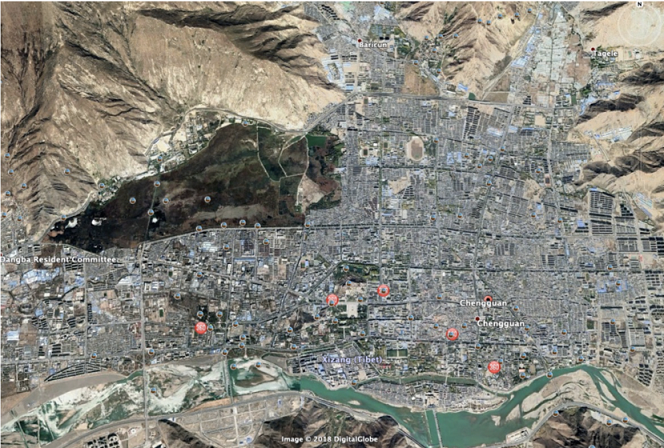
"Qomolangma") is not to be missed.
to keep this ecologically vital area pristine for the benefit of generations to come.

being hooded at the first Future Generations
University commencement.
with our students doesn't end at graduation. Alumni enter into a Global Network of global development and change practitioners
that continues to support their work and education, creating a true universe of lifelong learning.

improve conditions in marginalized mountain communities around the world, getting their start in 1992 when a research charge from UNICEF
led to the founding of Future Generations, Inc. Future Generations University operates now to teach development workers around the world
how to affect just and lasting changes where they live.
Future Generations History in the Tibet Autonomous Region
Future Generations staff have been organizing and leading projects in the Tibet Autonomous Region of China since 1983 and were among the first outsiders to work in modern Tibet. In 1983, a key staff member was the UNICEF Representative in China and the individual who first opened UN work in Tibet. In 1984, the former Vice President of China Programs opened one of the first cultural exchanges between the United States and Tibet through a tour with Robert Rauschenberg. In 1985, expedition leader, Daniel Taylor, opened the first collaboration in Tibet by bringing together the NGO sector and the government to establish the Qomolangma National Nature Preserve, first through The Mountain Institute of which he was the President and then through Future Generations where he is currently President.
When this conservation effort began across the QNNP region there was massive deforestation and wildlife slaughter. From the outset, Future Generations staff have been instrumental in the creation and design of the QNNP and the remarkable conservation successes that have followed. Future Generations helped develop and ten years later helped revise a master plan for this giant preserve, and are training local people in conservation management, community development, and ecotourism.
An exciting community-based mobilization began in 1993, developing community workers called “Pendebas” (“workers who benefit the village”). In 2014 the Pendeba Society (with now 800 Pendebas across Tibet) was recognized by the United Nations with one of the prestigious “Equator Prizes,” an award that is given every two years.
Future Generations continues to be the lead international agency in creating the major partnership for village-based social development, a program that is known as the Pendeba Program. Future Generations has been the lead
organization in most of the major physical infrastructure assistance projects for the QNNP: these include architectural design and funding of the preserve headquarters, building a library, two schools, restoring the Paba and ChuWa Temples, restoration of the famous Rongbuk Nunnery, and supporting construction of numerous community tree nurseries.
Future Generations has also supported and participated in more than 65 survey, training and educational trips within the Tibet Autonomous Region to document and share with others the biological richness of the region as well as bring new skills to projects. See Tibet Environmental Watch Report from 1999, “Tibet’s Environmental Good Samaritans: Saving a Valley and a Village’s Livelihood.”
Research expeditions have documented flora, fauna, cultural sites, anthropology, and economic conditions throughout Tibet, culminating in the book Across the Tibetan Plateau: Ecosystems, Wildlife, and Conservation, published by W.W. Norton in 2007. Institutional personnel have worked in all prefectures, setting up two other major nature preserves in addition to the QNNP, including the Lhalu Wetlands and Four Great Rivers.
The Lalu Wetlands National Park of Lhasa
 This expedition begins in Kathmandu to finalize entry permits into the Tibetan region of China and begin acclimatization. Then we fly from Kathmandu to Lhasa where we spend three more nights acclimatizing and meeting colleagues who helped set up the Everest park (and seven others across Tibet) decades ago. Of course we shall see Lhasa’s spectacular sights, including the Lalu Wetlands National Park (one of the parks Future Generations started). See the aerial imagery on left: It is the largest urban national park in the world (twice the size of New York’s Central Park).
This expedition begins in Kathmandu to finalize entry permits into the Tibetan region of China and begin acclimatization. Then we fly from Kathmandu to Lhasa where we spend three more nights acclimatizing and meeting colleagues who helped set up the Everest park (and seven others across Tibet) decades ago. Of course we shall see Lhasa’s spectacular sights, including the Lalu Wetlands National Park (one of the parks Future Generations started). See the aerial imagery on left: It is the largest urban national park in the world (twice the size of New York’s Central Park).
The satellite view of this park positions it between the Dalai Lama’s Potala Palace on the east side and the huge Drepung Monastery on the west where 10,000 monks once lived, and Sera Monastery on the north. As Lhasa City expanded five-fold in the last thirty years, this inside-the-city national park is an example of sustainable living.
Learn to Make Change Happen
Learn to Make Change Happen
Future Generations University Blog: This Blog highlights successes and experiences around our world-changing family. Read More
 Visit the University website - Future.Edu
Visit the University website - Future.Edu








